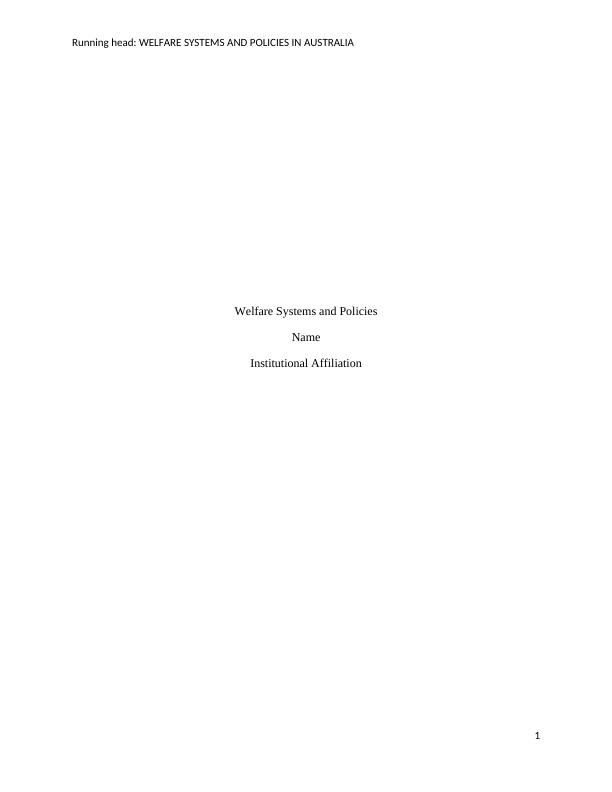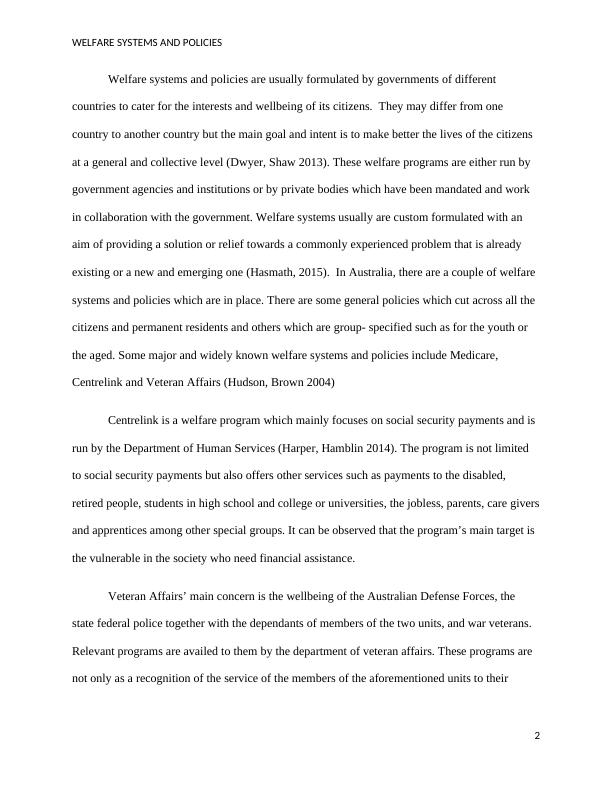Welfare Systems and Policies in Australia
Added on 2023-06-03
6 Pages1468 Words455 Views
Running head: WELFARE SYSTEMS AND POLICIES IN AUSTRALIA
Welfare Systems and Policies
Name
Institutional Affiliation
1
Welfare Systems and Policies
Name
Institutional Affiliation
1

WELFARE SYSTEMS AND POLICIES
Welfare systems and policies are usually formulated by governments of different
countries to cater for the interests and wellbeing of its citizens. They may differ from one
country to another country but the main goal and intent is to make better the lives of the citizens
at a general and collective level (Dwyer, Shaw 2013). These welfare programs are either run by
government agencies and institutions or by private bodies which have been mandated and work
in collaboration with the government. Welfare systems usually are custom formulated with an
aim of providing a solution or relief towards a commonly experienced problem that is already
existing or a new and emerging one (Hasmath, 2015). In Australia, there are a couple of welfare
systems and policies which are in place. There are some general policies which cut across all the
citizens and permanent residents and others which are group- specified such as for the youth or
the aged. Some major and widely known welfare systems and policies include Medicare,
Centrelink and Veteran Affairs (Hudson, Brown 2004)
Centrelink is a welfare program which mainly focuses on social security payments and is
run by the Department of Human Services (Harper, Hamblin 2014). The program is not limited
to social security payments but also offers other services such as payments to the disabled,
retired people, students in high school and college or universities, the jobless, parents, care givers
and apprentices among other special groups. It can be observed that the program’s main target is
the vulnerable in the society who need financial assistance.
Veteran Affairs’ main concern is the wellbeing of the Australian Defense Forces, the
state federal police together with the dependants of members of the two units, and war veterans.
Relevant programs are availed to them by the department of veteran affairs. These programs are
not only as a recognition of the service of the members of the aforementioned units to their
2
Welfare systems and policies are usually formulated by governments of different
countries to cater for the interests and wellbeing of its citizens. They may differ from one
country to another country but the main goal and intent is to make better the lives of the citizens
at a general and collective level (Dwyer, Shaw 2013). These welfare programs are either run by
government agencies and institutions or by private bodies which have been mandated and work
in collaboration with the government. Welfare systems usually are custom formulated with an
aim of providing a solution or relief towards a commonly experienced problem that is already
existing or a new and emerging one (Hasmath, 2015). In Australia, there are a couple of welfare
systems and policies which are in place. There are some general policies which cut across all the
citizens and permanent residents and others which are group- specified such as for the youth or
the aged. Some major and widely known welfare systems and policies include Medicare,
Centrelink and Veteran Affairs (Hudson, Brown 2004)
Centrelink is a welfare program which mainly focuses on social security payments and is
run by the Department of Human Services (Harper, Hamblin 2014). The program is not limited
to social security payments but also offers other services such as payments to the disabled,
retired people, students in high school and college or universities, the jobless, parents, care givers
and apprentices among other special groups. It can be observed that the program’s main target is
the vulnerable in the society who need financial assistance.
Veteran Affairs’ main concern is the wellbeing of the Australian Defense Forces, the
state federal police together with the dependants of members of the two units, and war veterans.
Relevant programs are availed to them by the department of veteran affairs. These programs are
not only as a recognition of the service of the members of the aforementioned units to their
2

WELFARE SYSTEMS AND POLICIES
country but also as a way of ensuring that they are able to live better lives together with their
dependants even after being actively involved in public service.
Medicare is Australia’s universal health care system which is provided by the
commonwealth government and is accessible by the Australian citizens and permanent residents.
Medicare was birthed from Medibank, a health insurance plan which was existing. Despite there
being an increase in the number of citizens who had began subscribing to health insurance plans
after the World War II, there were other Australians, particularly low income earners who could
still not access health insurance policies. The Whitlam Labor government which had been in
office beginning on 1972 had come up with a bill that sought to provide health care insurance to
all of the citizens so that even the low income earners were catered for. It was passed in 1974 and
began its operations in 1975 but was later renamed to Medicare after some restructuring in 1984
under a new government (Hudson, Brown 2004).
Medicare receives its funding from the additional percentage which was legally added on
the income tax of Australians, with low income earners being exempted from the medical levy.
The high income earners on the other end are usually encouraged to access private health
insurance policies in order to reduce the big demand that is placed on the public health insurance
schemes. Rebates/ benefits are what the citizens receive under the health insurance plan (Willis,
Reynolds & Keleher 2012).
Medicare is subdivided into four main groups, on the basis of the areas and health
services which they cover. There is Part A, B. C and D. Part A is also referred to as hospital
insurance covers the following areas; hospice services, nursing facilities, medically advised
home health care and admitted patients. Part B is the medical insurance whose role is to cover
3
country but also as a way of ensuring that they are able to live better lives together with their
dependants even after being actively involved in public service.
Medicare is Australia’s universal health care system which is provided by the
commonwealth government and is accessible by the Australian citizens and permanent residents.
Medicare was birthed from Medibank, a health insurance plan which was existing. Despite there
being an increase in the number of citizens who had began subscribing to health insurance plans
after the World War II, there were other Australians, particularly low income earners who could
still not access health insurance policies. The Whitlam Labor government which had been in
office beginning on 1972 had come up with a bill that sought to provide health care insurance to
all of the citizens so that even the low income earners were catered for. It was passed in 1974 and
began its operations in 1975 but was later renamed to Medicare after some restructuring in 1984
under a new government (Hudson, Brown 2004).
Medicare receives its funding from the additional percentage which was legally added on
the income tax of Australians, with low income earners being exempted from the medical levy.
The high income earners on the other end are usually encouraged to access private health
insurance policies in order to reduce the big demand that is placed on the public health insurance
schemes. Rebates/ benefits are what the citizens receive under the health insurance plan (Willis,
Reynolds & Keleher 2012).
Medicare is subdivided into four main groups, on the basis of the areas and health
services which they cover. There is Part A, B. C and D. Part A is also referred to as hospital
insurance covers the following areas; hospice services, nursing facilities, medically advised
home health care and admitted patients. Part B is the medical insurance whose role is to cover
3

End of preview
Want to access all the pages? Upload your documents or become a member.
Related Documents
Medicare in Australia: A Comprehensive Overviewlg...
|11
|841
|386
Health Insurance in Australia: Factors, Statistics, and Coveragelg...
|13
|3531
|1
Factors which have shaped the Australian Health Sectorlg...
|10
|2756
|85
Contemporary Australian Society : Assignmentlg...
|6
|1441
|222
Australian Health Care Policylg...
|10
|1953
|95
History and Impact of Medicare Policy in Australialg...
|10
|2280
|425
